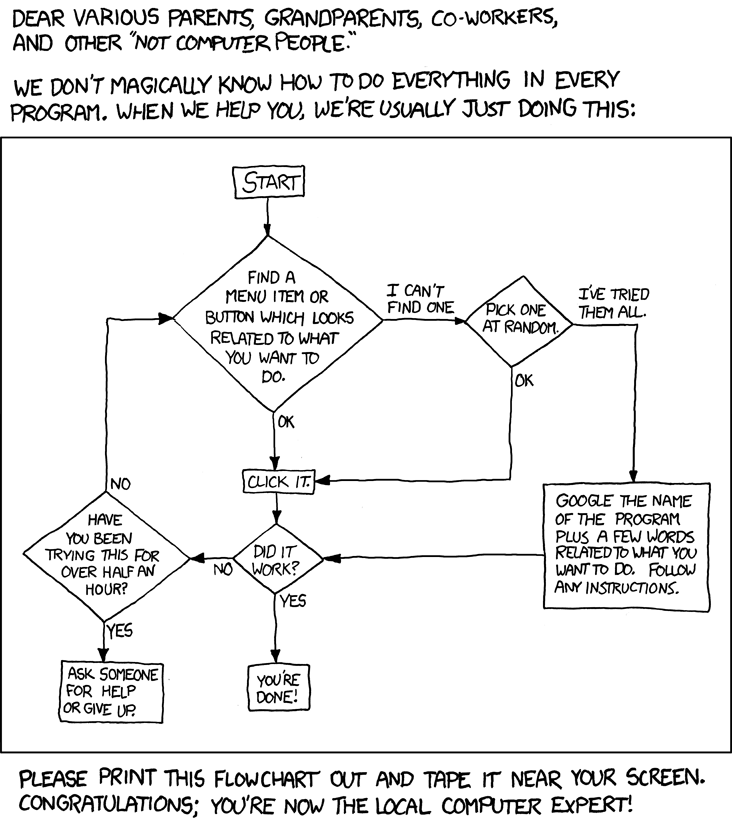Algorithms and Problem Solving
Chapter 1
Algorithms and Flowcharts (Designing a Program)
Reference this presentation for your first homework.
Five Simple Ideas Used to Create All Programs
- Sequential Processing
- A list of instructions performed in order
- Conditional Execution
- If…, then…, else…
- Looping or Iteration
- Repeated behavior (i.e., while there are cookies on the plate, keep eating cookies)
- Problem Decomposition (i.e., stepwise refinement, top-down design)
- Breaking the problem into sub-problems that can be solved independently.
- Functions
- A set of instructions that return a single result (answer a question).
Complexity
Most computers only really “understand” about 100 different instructions.
Powerful applications take advantage of the extreme number of possible instruction combinations.
Chess is a good analogy:
- 6 types of pieces; each piece moves in a simple pattern.
- Possible/playable chess games (assuming an avg. game has 30 moves) are 4,670,033.
Algorithms
An algorithm is A step-by-step list of instructions for solving a problem. The solution must be determined in a finite amount of time.
Algorithms can be expressed in many kinds of notations (e.g., natural language, pseudocode, flowcharts, etc.)
Flowcharts
A flowchart is one way to represent an algorithm and uses the following symbols.
| Symbol | Name | Description |
|---|---|---|
| Terminal | Indicates the beginning and ending of an algorithm. | |
| Flow Line | Shows the order of operation by connecting one symbol to the next symbol. | |
| Input/Output | An action where either input is received from outside the program (from the user, a text file, etc.) or the program is outputting information (on the screen, to a file, to a printer, etc.) | |
| Process | The execution of any mathematical operation or other built-in instruction(s). | |
| Call-Process | An action defined elsewhere (in another flowchart). | |
| Decision | An action where a decision is made where the outcome is either true or false (Boolean). | |
 | Flow Connector | Multiple arrows converge at a flow connector. |
 | Off-Page Connector | Indicates that the flowchart continues on another page. |
Check for Flowchart Errors
Take a look at the flowchart below. Identify as many formatting errors as you can and note how you would correct them. In the above video, I identify the ones I found and how I may correct them.

Practice: Create Algorithms
Create flowchart for the the following to who how the following problems would be solved. Note that they build on one another.
- Create an algorithm to count from 1 to 1000.
- Change the algorithm to count to a user-inputted number.
- Change the algorithm to count down from the user’s number to 1.
- Change the algorithm to output the sum of all the numbers.
The solution to the first problem is given in the above lecture video. Check if you did something similar.
Creating Solutions
- Algorithm
- Step-by-step problem-solving process
- In a finite amount of time
- Programming is a process of problem-solving.
Programming with the Problem Analysis–Coding–Execution Cycle
Analyze the problem
- Thoroughly understand the problem and all requirements
- Does the program require user interaction?
- Does the program manipulate data?
- What is the output?
- If the problem is complex, divide it into subproblems
- Analyze and design algorithms for each subproblem
- Check the correctness of the algorithm
- Can test using sample data
- Some mathematical analysis might be required
- Thoroughly understand the problem and all requirements
Implement the algorithm
- Once the algorithm is designed and correctness verified, write the equivalent code in a high-level language.
- Enter the program using a text editor. This is called the implementation of the algorithm.
- Compile code
- If the compiler generates errors
- Look at the code and remove errors
- Run code again through the compiler
- If there are no syntax errors, the compiler generates equivalent machine code.
- The compiler guarantees that the program follows the rules of the language. It does not guarantee that the program will run correctly.
- Linker links machine code with system resources
- Once the algorithm is designed and correctness verified, write the equivalent code in a high-level language.
Execution (run the compiles program)
- Once compiled and linked, the loader can place the program into the main memory for execution.
- The final step is to execute the program.
Maintenance
- Use and modify the program if the problem domain changes.
Programming Methods
Two popular approaches to programming design
- Structured (e.g., Procedural)
- Object-oriented
There are many other programming paradigms.
Structured Programming
Procedural design is a subset of structured design:
- Dividing a problem into smaller subproblems
- A solution to a subproblem is a “module” or “procedure” and is simply a series of computation steps to be carried out.
- The procedural design approach is also called:
- Top-down (or bottom-up) design
- Stepwise refinement
- Modular programming
Object-Oriented Programming
Object-oriented design:
- Identify components called objects.
- Determine how objects interact with each other
- Specify relevant data and possible operations to be performed on that data.
- Each object consists of data and operations on that data.
- An object combines data and operations on the data into a single unit
- A language that supports object-oriented design is called an object-oriented programming (OOP) language
- Must learn how to represent data in computer memory, how to manipulate data, and how to implement operations.
- C++ was designed to support object-oriented programming.
- Object-oriented design is used with structured design.